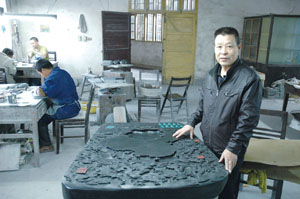Cao Jieming, born in 1954, learned inkslab engraving as a boy from master of the craft Wang Lüsen. After 40 years of study and practice of inkslab engraving, Cao has evolved a distinctively refined style, apparent in strong but smooth carved lines. Cao’s representative works have won multiple awards at national and international exhibitions. In 2006, Cao was officially designated as national representative inheritor of the She inkslab making craft.
 |
|
Curious about the She inkslab making art and craft, and intent on exploring the broad and profound Hui Culture, we made a special trip to the city of Huangshan in Anhui province, east China. There we met Cao Jieming, master of inkslab engraving, in the Anhui She Inkslab Factory in Shexian county. Influenced by traditional Chinese culture, Cao has since his youth been passionate about painting and calligraphy. In the refined, courteous manner that typifies traditional Chinese literati, Cao told us about his path along the craft of She inkslab engraving, from apprentice to master.
Rehabilitating a Traditional Craft
Mention of inkslabs brings to mind the Chinese wenfang sibao – Four Treasures of the Study, namely the writing brush, inkstick, inkslab, and rice paper. As essential tools of venerable Chinese literati, inkslabs, with their hard, impermeable texture, are often considered collectors’ items. The She inkslab was named after its place of origin, Shexian county. It has been acclaimed as one of the four famous inkslabs in China by virtue of its excellent quality, along with the Duan inkslab made in Zhaoqing of Guangdong province, the Taohe inkslab of Taozhou, Gansu province, and the Chengni inkslab produced in Jiangxian county, Shanxi province.
According to Cao, the She inkslab is noted for its tough and tensile, fine and smooth texture, and beautiful veins. It does not absorb water or inflict harm on the writing brush, and ink ground on it is as silky as oil. The slab also emits a satisfying metallic ring when tapped. All these merits made it worthy as a royal tribute as far back as the Tang Dynasty (618 - 907). At the beginning of the 20th century, incessant wars and chaos stopped production of She inkslabs. Many crafters consequently sought work in more mundane occupations, and the future of She inkslab carving looked dim.
After the founding of the People’s Republic in 1949, and under the protection and support of the government, She inkslab making began to gather new development momentum. “In October 1964, with the production of the first She inkslab since the founding of New China, the craft was finally rehabilitated,” Cao recalled.
She inkslab engraving usually features traditional bas-relief in a distinctive local style, the result of learning and exchanges over generations among local inkslab engraving, woodblock carving, inkstick molding and brick sculpture craftsmen. “Certain local handicraft masters, like wood sculptor Wang Jinsheng and brick sculptor Fang Xinzhong, are good friends of mine. We often meet to compare notes. We are sculptors in different ways, so our works share many common elements,” Cao said.
We recommend:
